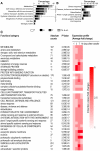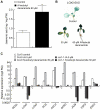Alkamides activate jasmonic acid biosynthesis and signaling pathways and confer resistance to Botrytis cinerea in Arabidopsis thaliana
- PMID: 22076141
- PMCID: PMC3208606
- DOI: 10.1371/journal.pone.0027251
Alkamides activate jasmonic acid biosynthesis and signaling pathways and confer resistance to Botrytis cinerea in Arabidopsis thaliana
Abstract
Alkamides are fatty acid amides of wide distribution in plants, structurally related to N-acyl-L-homoserine lactones (AHLs) from Gram-negative bacteria and to N- acylethanolamines (NAEs) from plants and mammals. Global analysis of gene expression changes in Arabidopsis thaliana in response to N-isobutyl decanamide, the most highly active alkamide identified to date, revealed an overrepresentation of defense-responsive transcriptional networks. In particular, genes encoding enzymes for jasmonic acid (JA) biosynthesis increased their expression, which occurred in parallel with JA, nitric oxide (NO) and H₂O₂ accumulation. The activity of the alkamide to confer resistance against the necrotizing fungus Botrytis cinerea was tested by inoculating Arabidopsis detached leaves with conidiospores and evaluating disease symptoms and fungal proliferation. N-isobutyl decanamide application significantly reduced necrosis caused by the pathogen and inhibited fungal proliferation. Arabidopsis mutants jar1 and coi1 altered in JA signaling and a MAP kinase mutant (mpk6), unlike salicylic acid- (SA) related mutant eds16/sid2-1, were unable to defend from fungal attack even when N-isobutyl decanamide was supplied, indicating that alkamides could modulate some necrotrophic-associated defense responses through JA-dependent and MPK6-regulated signaling pathways. Our results suggest a role of alkamides in plant immunity induction.
Conflict of interest statement
Figures







Similar articles
-
Arabidopsis WRKY33 is a key transcriptional regulator of hormonal and metabolic responses toward Botrytis cinerea infection.Plant Physiol. 2012 May;159(1):266-85. doi: 10.1104/pp.111.192641. Epub 2012 Mar 5. Plant Physiol. 2012. PMID: 22392279 Free PMC article.
-
Priming for JA-dependent defenses using hexanoic acid is an effective mechanism to protect Arabidopsis against B. cinerea.J Plant Physiol. 2011 Mar 1;168(4):359-66. doi: 10.1016/j.jplph.2010.07.028. Epub 2010 Oct 14. J Plant Physiol. 2011. PMID: 20950893
-
Jasmonic Acid Oxidase 2 Hydroxylates Jasmonic Acid and Represses Basal Defense and Resistance Responses against Botrytis cinerea Infection.Mol Plant. 2017 Sep 12;10(9):1159-1173. doi: 10.1016/j.molp.2017.07.010. Epub 2017 Jul 29. Mol Plant. 2017. PMID: 28760569
-
Jasmonic Acid at the Crossroads of Plant Immunity and Pseudomonas syringae Virulence.Int J Mol Sci. 2020 Oct 11;21(20):7482. doi: 10.3390/ijms21207482. Int J Mol Sci. 2020. PMID: 33050569 Free PMC article. Review.
-
Jasmonic Acid as a Mediator in Plant Response to Necrotrophic Fungi.Cells. 2023 Mar 27;12(7):1027. doi: 10.3390/cells12071027. Cells. 2023. PMID: 37048100 Free PMC article. Review.
Cited by
-
Jasmonates: biosynthesis, perception, signal transduction and action in plant stress response, growth and development. An update to the 2007 review in Annals of Botany.Ann Bot. 2013 Jun;111(6):1021-58. doi: 10.1093/aob/mct067. Epub 2013 Apr 4. Ann Bot. 2013. PMID: 23558912 Free PMC article. Review.
-
Chemistry and Pharmacology of Alkylamides from Natural Origin.Rev Bras Farmacogn. 2020;30(5):622-640. doi: 10.1007/s43450-020-00095-5. Epub 2020 Oct 9. Rev Bras Farmacogn. 2020. PMID: 33071385 Free PMC article. Review.
-
Jasmonates: Multifunctional Roles in Stress Tolerance.Front Plant Sci. 2016 Jun 15;7:813. doi: 10.3389/fpls.2016.00813. eCollection 2016. Front Plant Sci. 2016. PMID: 27379115 Free PMC article. Review.
-
The cyclic nucleotide cGMP is involved in plant hormone signalling and alters phosphorylation of Arabidopsis thaliana root proteins.J Exp Bot. 2012 May;63(8):3199-205. doi: 10.1093/jxb/ers045. Epub 2012 Feb 15. J Exp Bot. 2012. PMID: 22345640 Free PMC article.
-
A mutation in the expansin-like A2 gene enhances resistance to necrotrophic fungi and hypersensitivity to abiotic stress in Arabidopsis thaliana.Mol Plant Pathol. 2013 Oct;14(8):813-27. doi: 10.1111/mpp.12049. Epub 2013 Jun 19. Mol Plant Pathol. 2013. PMID: 23782466 Free PMC article.
References
-
- Glazebrook J. Genes controlling expression of defense responses in Arabidopsis - 2001 status. Curr Opin Plant Biol. 2001;4:301–308. - PubMed
-
- Wendehenne D, Courtois C, Besson A, Gravot A, Buchwalter A, et al. Lamattina L, Polacco JC, editors. NO-based signaling in plants. Nitric oxide in plant growth. 2006. pp. 35–51. Plant Cell Monogr vol 6. Springer-Verlag, Berlin Heidelberg New York.
-
- Satner A, Estelle M. Recent advances and emerging trends in plant hormone signaling. Nature. 2009;459:1071–1078. - PubMed
-
- Shah J. Lipids, lipases, and lipid-modifying enzymes in plant disease resistance. Annu Rev Phytopathol. 2005;43:229–260. - PubMed
-
- Upchurch RG. Fatty acid unsaturation, mobilization, and regulation in the response of plants to stress. Biotech Lett. 2008;30(6):967–977. - PubMed
Publication types
MeSH terms
Substances
Grants and funding
LinkOut - more resources
Full Text Sources
Molecular Biology Databases

